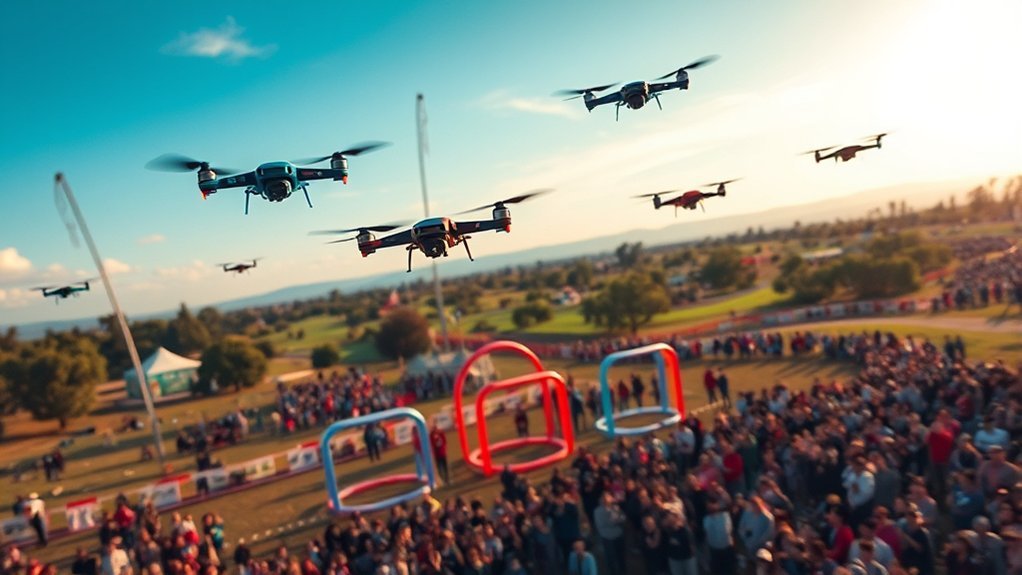Did you know that FPV racing drones in 2025 have dramatically evolved to offer unprecedented speed and precision? These advancements cater to both newcomers and seasoned pilots, enhancing the overall racing experience. With a variety of models designed for different skill levels, it’s essential to understand what makes each drone unique. Let’s explore the top contenders that promise to elevate your racing game and keep you ahead of the competition.
FPV Drone with VR Glasses and Obstacle Avoidance
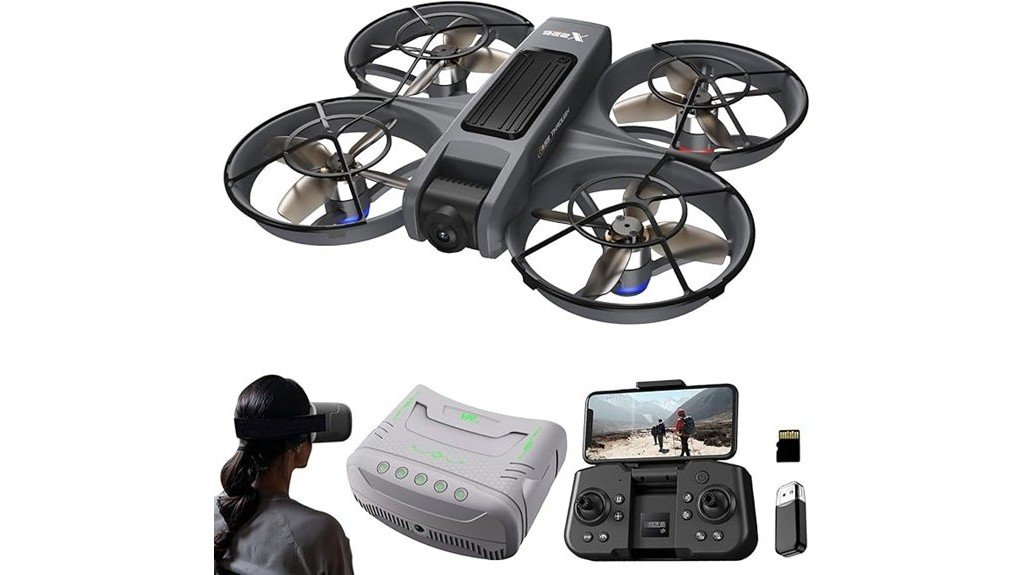
If you’re looking for an exciting way to plunge into FPV racing, the FPV Drone with VR Glasses and obstacle avoidance is an ideal choice for both kids and adults alike. With a high-performance brushless motor, you’ll enjoy stable and speedy flights. Capture stunning 1080P HD videos and images, while the altitude hold guarantees smooth handling. You’ll love the VR glasses that provide an immersive first-person view. It boasts impressive features like smart tracking, 360° flips, and easy one-button takeoff. Plus, its sturdy design makes it crash-resistant, perfect for beginners venturing into the thrilling world of FPV racing.
Best For: Those seeking an engaging FPV racing experience suitable for both beginners and experienced users.
Pros:
- High-performance brushless motor ensures stability and speed during flights.
- Includes immersive VR glasses for a first-person flight experience.
- Features like obstacle avoidance and altitude hold enhance user safety and ease of use.
Cons:
- Customer ratings are relatively low at 3.5 out of 5 stars.
- Limited flight range of 100 meters may restrict outdoor use.
- Only a 30-day return policy may not provide enough time for thorough testing.
APEX FPV Drone Kit for Beginners
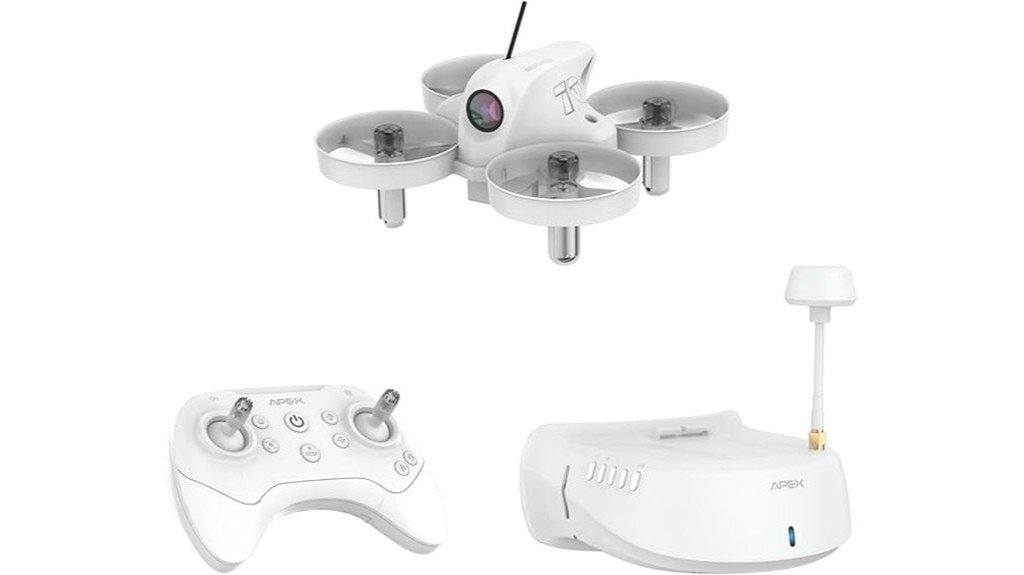
The APEX FPV Drone Kit, designed specifically for beginners, offers an immersive flight experience that sets it apart in the world of FPV racing. With low-latency 5.8G transmission and a lightweight build of just 100 grams, you’ll enjoy smooth, real-time flying. The included FPV goggles provide a 120° view, making every flight exhilarating. You can choose between Manual Mode for freestyle flying or the Beginner Mode, which stabilizes the drone for easy control. With three rechargeable batteries, you’ll get 15-18 minutes of flight time. Plus, it’s compatible with popular simulators, enhancing your skills in no time.
Best For: The APEX FPV Drone Kit is best for beginners looking to experience FPV racing with an easy-to-use, immersive drone.
Pros:
- Immersive Experience: Comes with FPV goggles providing a 120° view for real-time flight enjoyment.
- Lightweight Design: At just 100 grams, it’s easy to handle and maneuver, making it ideal for new pilots.
- Multiple Flight Modes: Offers both Manual Mode for advanced flying and Beginner Mode for stability and ease of control.
Cons:
- Limited Flight Time: With only 15-18 minutes of flight time per battery, you’ll need to recharge frequently.
- Basic Video Quality: Video capture resolution is only 480p, which may not satisfy users looking for high-definition footage.
- Customer Ratings: Holds an average rating of 3.8 out of 5 stars, indicating mixed customer satisfaction.
BETAFPV ELRS V3 Aquila16 FPV Kit with LiteRadio 2 SE Transmitter
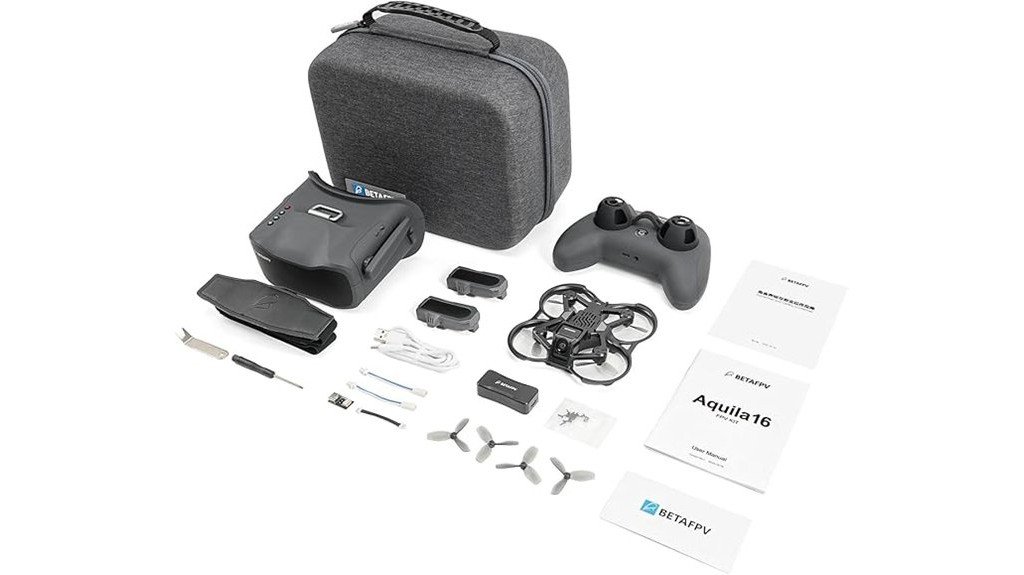
Designed specifically for FPV beginners, the BETAFPV ELRS V3 Aquila16 FPV Kit with LiteRadio 2 SE Transmitter makes entering the world of drone racing accessible and enjoyable. With flight times of up to 8 minutes and a range of 200 meters, you’ll experience great performance both indoors and outdoors. The LiteRadio 2 SE transmitter is user-friendly, offering multiple flight modes to match your skill level. Plus, the VR03 goggles provide real-time video transmission and DVR recording. Although advanced users might find limitations, this kit’s durability and ease of setup make it an excellent choice for those just starting their FPV journey.
Best For: The BETAFPV ELRS V3 Aquila16 FPV Kit is best for beginners looking to explore the world of FPV drone flying with a user-friendly setup.
Pros:
- Long flight time of up to 8 minutes is ideal for beginners.
- Durable construction allows it to withstand crashes.
- Multiple flight modes cater to different skill levels, enhancing the learning experience.
Cons:
- Limited performance in Acro mode may be frustrating for advanced users.
- Absence of a buzzer for alerts can be a drawback.
- Video quality may diminish in low-light conditions.
Tinyhawk 3 PLUS+ RTF Kit Analog FPV Drone
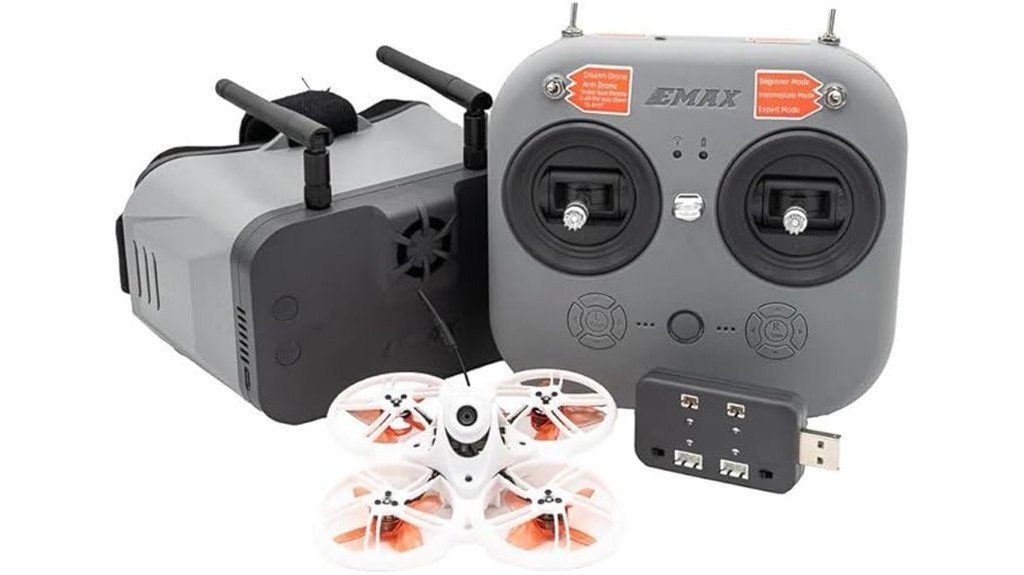
Looking for an excellent entry point into FPV racing? The Tinyhawk 3 PLUS+ RTF Kit is perfect for you. Weighing just 23 grams and built with a durable frame, this mini racing quadcopter offers reliability and performance. With enhanced signal strength and optimized analog systems, you’ll enjoy stable flights even in challenging environments. Plus, it comes with two rechargeable batteries, ensuring you stay in the air longer. Suitable for both beginners and professionals, the Tinyhawk 3 PLUS+ is designed to help you hone your skills. Don’t forget, it’s also compatible with flight sims for added practice.
Best For: The Tinyhawk 3 PLUS+ RTF Kit is best for beginners and professionals looking to enter the world of FPV racing with a reliable and lightweight drone.
Pros:
- Durable design ensures longevity and withstands challenging flying conditions.
- Lightweight at just 23 grams, making it easy to maneuver and control.
- Includes two rechargeable batteries for extended flying time.
Cons:
- Battery level display can malfunction, leading to potential confusion about remaining power.
- Remote connection issues may arise when using for sim play.
- Average customer rating of 2.9 out of 5 stars indicates mixed feedback from users.
Tiny Hawk RTF Micro Indoor Racing Drone with FPV Goggles and Controller

For aspiring drone racers and beginners, the Tiny Hawk RTF Micro Indoor Racing Drone stands out with its ready-to-fly kit that includes FPV goggles and a controller. This lightweight drone reaches speeds of up to 35 mph and features three racing modes to help you develop your skills. With a maximum range of 200 feet and a 720p camera, you’ll enjoy an immersive FPV experience. The compact design fits easily into small spaces, while the durable construction guarantees longevity. Plus, the included carbon fiber-themed carrying case makes transport a breeze. Just be prepared for a short flight time of about four minutes.
Best For: Beginners and aspiring drone racers looking for an easy-to-use, ready-to-fly FPV experience.
Pros:
- Lightweight and durable design enables speeds up to 35 mph, perfect for racing.
- Three adjustable racing modes (Level, Horizon, Full Acrobatic) cater to skill development.
- Compact carrying case included for convenient transport.
Cons:
- Flight time is limited to approximately four minutes, necessitating extra batteries for longer sessions.
- Some components may be fragile, impacting durability during use.
- Customer service experiences may vary, with reports of challenges regarding warranty support.
BETAFPV Cetus FPV RTF Drone Kit

The BETAFPV Cetus FPV RTF Drone Kit stands out as an excellent choice for beginners enthusiastic to immerse themselves in the world of FPV racing. This kit includes the Cetus Brushed Whoop Quadcopter, LiteRadio 2 SE transmitter, and VR02 FPV goggles. You’ll appreciate the self-protection function for safe emergency landings. The LiteRadio 2 SE lets you practice with FPV simulators, enhancing your skills before real flights. With the VR02 goggles, you’ll enjoy an immersive experience, complete with on-screen display information. Plus, the height hold function guarantees stability, making it perfect for indoor flying. Everything’s neatly packed for easy transport.
Best For: Beginners looking to dive into the world of FPV racing with a user-friendly and safe drone kit.
Pros:
- Easy to use with built-in self-protection for emergency landings.
- Includes a transmitter that supports FPV simulator practice for skill enhancement.
- Immersive VR02 FPV goggles with on-screen display for real-time flight information.
Cons:
- Height hold function is limited to N mode, which may restrict advanced maneuvers.
- Brushed motors may not provide as much power or durability as brushless options.
- The kit may not be suitable for advanced pilots seeking high-performance features.
QWinOut F4 X1 FPV Racing Drone with Goggles
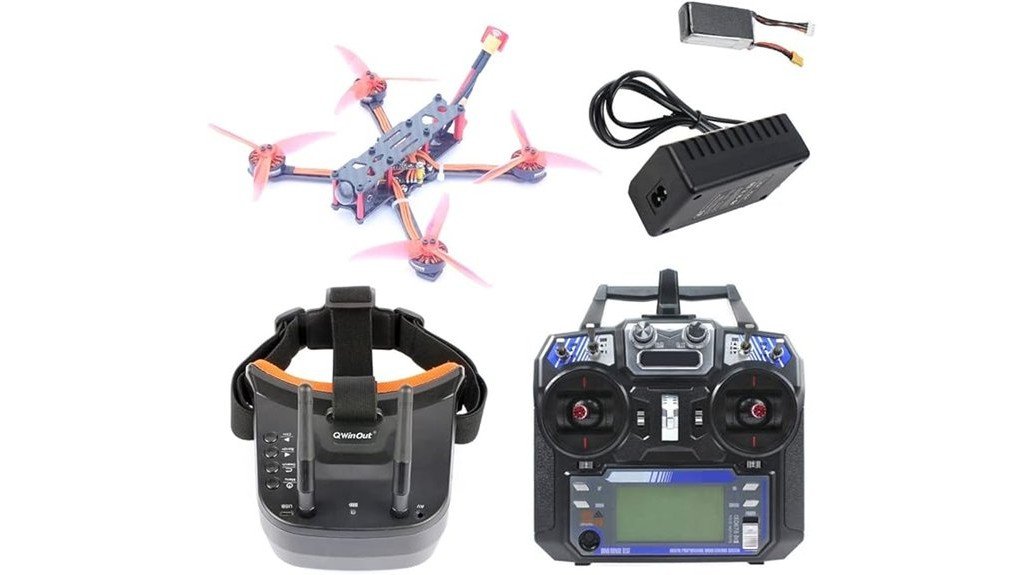
Packed with essential features for both new and aspiring racers, the QWinOut F4 X1 FPV Racing Drone makes an excellent choice for those just starting their journey into FPV racing. This Ready-to-Fly drone boasts a powerful F411 flight controller and 2900KV motors, ensuring quick responsiveness. The included Caddx Ratel camera captures stunning 720p video, while the OpenVTX module offers adjustable transmission power for versatile flying conditions. With a lightweight design and easy assembly, you’ll be racing in no time. While customer feedback suggests it’s best for ages 14 and up, it’s a fantastic entry point for thrilling FPV experiences.
Best For: The QWinOut F4 X1 FPV Racing Drone is best for beginners and aspiring racers aged 14 and up who are looking for an accessible entry into FPV racing.
Pros:
- Easy to assemble and fly after initial setup, making it beginner-friendly.
- Powerful F411 flight controller and 2900KV motors provide quick responsiveness.
- Adjustable transmission power with the OpenVTX module allows for versatile flying conditions.
Cons:
- Customer service and support may be lacking, leading to potential frustration.
- Recommended for users aged 14 and older, which may limit accessibility for younger enthusiasts.
- Some users suggest using a 4S battery for longer flight times, which requires an additional purchase.
Tinyhawk 3 Freestyle PLUS+ RTF Kit FPV Drone

Designed specifically for beginners, the Tinyhawk 3 Freestyle PLUS+ RTF Kit FPV Drone offers an approachable entry into the world of FPV racing. Weighing just 3.05 pounds, its durable carbon fiber frame and 2.5-inch propellers guarantee stability while flying. With enhanced signal strength, you’ll enjoy confident control in various environments. The kit includes two 450 mAh batteries, a remote control, and FPV goggles, making it a complete package. Rated 3.9 out of 5 stars, it’s popular among hobbyists. If you’re looking to build your skills, the Tinyhawk 3 is a reliable choice that won’t disappoint.
Best For: Beginners looking to enter the world of FPV racing with a reliable and easy-to-use drone.
Pros:
- Durable carbon fiber frame designed for stability and longevity.
- Enhanced signal strength allows for confident flying in various environments.
- Complete kit includes two batteries, remote control, and FPV goggles.
Cons:
- Weight may be slightly heavier compared to other beginner drones.
- Analog system might not appeal to users seeking high-definition video transmission.
- Limited advanced features for more experienced pilots.
BETAFPV ELRS Air75 Brushless Whoop Quadcopter

For advanced pilots seeking exhilarating FPV racing experiences, the BETAFPV ELRS Air75 Brushless Whoop Quadcopter stands out with its ultralight design and impressive agility. Weighing just 21g, this 75mm micro drone features a powerful 0802SE 23000KV motor, ensuring quick responses during races. The integrated G473 flight controller enhances stability, while the C03 FPV camera captures 720p video for clear visuals. With its advanced ExpressLRS control technology and durable design, you’re set for thrilling maneuvers. Pair it with the recommended LAVA 1S 450mAh battery for peak performance, making this whoop a top choice for serious racers.
Best For: Advanced pilots seeking high FPV agility and racing performance.
Pros:
- Exceptional agility and speed with a powerful 0802SE 23000KV motor.
- Lightweight design at just 21g, enhancing maneuverability.
- Integrated G473 flight controller provides improved stability and control.
Cons:
- May not be suitable for beginners due to its advanced features and handling.
- Requires matching firmware version (V3) for optimal operation, which can be complex for some users.
- Battery and additional components may need to be purchased separately for full functionality.
Tiny Hawk Freestyle 2 Micro Racing FPV Drone

The Tiny Hawk Freestyle 2 Micro Racing FPV Drone stands out as an excellent choice for aspiring racers who crave agility and precision. Weighing just 8.1 ounces and measuring 2.5 inches, its lightweight carbon fiber frame makes it easily maneuverable in tight spaces. Equipped with a 720p video capture resolution, this drone offers decent video quality, although some users note transmission issues. With two included 250mAh lithium polymer batteries, you can enjoy extended flying sessions. Plus, its compatibility with FRSKY D8 guarantees reliable control. Overall, the Tiny Hawk Freestyle 2 delivers a thrilling racing experience for beginners and enthusiasts alike.
Best For: The Tiny Hawk Freestyle 2 is best for aspiring racers and hobbyists looking for a compact and agile FPV drone for indoor and tight space racing.
Pros:
- Impressive handling allows for easy maneuvering in confined areas.
- Lightweight carbon fiber frame enhances durability while minimizing weight.
- Compatible with FRSKY D8, providing reliable control during flight.
Cons:
- Poor video transmission quality reported by some users.
- Limited operating temperature range may restrict use in colder conditions.
- Average customer rating of 3.6 out of 5 stars indicates mixed feedback on performance.
Factors to Consider When Choosing a Drone for FPV Racing
When choosing a drone for FPV racing, you’ll want to contemplate several key factors. Think about the drone’s weight and size, as they can impact your speed and maneuverability. Additionally, battery life, camera quality, flight modes, and transmission range will all play an essential role in your overall racing experience.
Drone Weight and Size
Choosing the right drone for FPV racing involves careful consideration of weight and size, as they directly influence performance. Lighter drones typically offer quicker maneuvers and better handling, making them ideal for racing scenarios. The weight-to-thrust ratio is essential; a high ratio enables rapid acceleration and climbing, giving you an edge on the track. When it comes to size, smaller drones excel at maneuvering through tight spaces, weaving through obstacles with ease. Most competitive FPV racing drones weigh between 100 grams and 1.5 kilograms, with many models under 250 grams for maximum speed and agility. Remember, a broader frame may offer stability but can hinder your speed compared to a compact design. Choose wisely to enhance your racing experience.
Battery Life Duration
Battery life duration plays an essential role in your FPV racing experience, as it determines how long you can stay in the air during critical moments. Most drones offer flight times between 4 to 18 minutes, depending on battery capacity and weight. High-performance Lithium Polymer (LiPo) batteries are preferred for their lightweight and high discharge rates, enhancing your drone’s performance. Keep in mind that a battery’s capacity, measured in milliamp hours (mAh), affects flight time; higher capacity can mean longer flights but may increase weight, impacting maneuverability. Additionally, effective battery management systems, featuring low voltage warnings and over-discharge protection, help maintain battery health. To maximize your flying experience, consider carrying multiple batteries to reduce downtime between races.
Camera Quality and Resolution
Camera quality and resolution are essential components in FPV racing, as they greatly influence your ability to navigate and react quickly. A minimum resolution of 720p is recommended to guarantee you capture enough detail, helping you identify obstacles and track your position effectively. Aim for drones with higher frame rates, ideally 60fps or more, for smoother video playback during fast maneuvers. The type of camera sensor matters too; CMOS sensors typically perform better in varying light conditions compared to CCD sensors. Additionally, adjustable camera angles can enhance your perspective, allowing for optimized viewing based on racing conditions and your drone’s flight path. Prioritize these features to elevate your FPV racing experience.
Flight Modes Available
When you immerse yourself in FPV racing, understanding the various flight modes available can greatly enhance your experience and performance. Many drones offer modes like Level Mode for stability, perfect for beginners. This mode, along with altitude hold features, makes controlling your drone easier and reduces the learning curve. As you advance, you might prefer Full Acrobatic Mode, giving you complete control over pitch, roll, and yaw for intricate stunts and speed. Horizon Mode offers a balance for gentle acrobatics. Don’t overlook Turtle Mode, which helps you recover from upside-down crashes. Remember, flight modes can impact battery life; faster modes may drain your battery quicker than stability-focused options, so choose wisely to maximize your racing time.
Transmission Range and Technology
Choosing the right drone for FPV racing involves more than just flight modes; transmission range and technology play an essential role in your overall experience. The transmission range is vital, as it determines how far you can operate your drone while keeping a stable video feed. Ranges can vary from 100 meters to over 1,000 feet based on the drone’s capabilities. Low-latency technology, like 5.8G, is preferred for real-time video feedback, fundamental for quick maneuvering. Look for higher transmission power (200mW to 600mW) for robust signals over longer distances, but remember that obstacles can affect performance. Finally, make sure your FPV goggles and receivers match the chosen technology to maximize your racing potential.
Durability and Crash Resistance
While you might be excited about speed and agility, durability and crash resistance are just as important when it comes to FPV racing drones. Crashes are inevitable, so choosing models with reinforced frames and materials can greatly boost your drone’s crash resistance. Look for a rigid body design that features reinforced weak points to help maintain structural integrity during those high-speed maneuvers. Lightweight materials are essential for agility, yet they should still offer the durability you need. Many drones come with protective designs like duct guards or canopies that protect propellers and sensitive components during collisions. Finally, investing in drones with modular components makes repairs easier, ensuring minimal downtime and keeping you competitive in racing events.
Ease of Setup
Setting up your FPV racing drone shouldn’t feel like an intimidating task. Look for drones that come pre-bound with transmitters and goggles; this cuts down setup time considerably, especially for beginners. Kits with thorough user manuals and quick start guides can make your initial setup smoother. You’ll also want drones with modular components, allowing for easy installation and replacement, which minimizes downtime. If you can, choose a drone that supports FPV simulators; practicing virtually helps you grasp the setup before hitting the skies. Finally, verify your drone features plug-in type motors and components, as these simplify maintenance and speed up the setup process after crashes or repairs. Enjoy your flying experience with less hassle!
Compatibility With Accessories
When diving into FPV racing, compatibility with accessories plays an essential role in enhancing your overall flying experience. You’ll want to guarantee your drone works seamlessly with various FPV goggles, as different models support different transmission technologies like 5.8G or Wi-Fi. Check if the drone’s transmitter is compatible with FPV simulators, allowing you to practice without risking your gear. Battery type and specifications should also align with your chargers and backup batteries, affecting flight time and convenience. Look for standardized communication protocols, such as S.BUS, to guarantee compatibility with a broader range of receivers and controllers. Finally, assess if the camera and video transmission system can integrate with aftermarket components for future enhancements.
Frequently Asked Questions
What Are the Best Battery Options for FPV Racing Drones?
When you’re soaring like a hawk, consider high-capacity LiPo batteries for your FPV racing drone. They deliver punchy power and quick recharge times, ensuring you stay ahead of the competition with every exhilarating flight.
How Can I Improve My Piloting Skills for FPV Racing?
Practice regularly in various environments, focusing on smooth control and quick reflexes. Use simulators to enhance your skills and analyze your flights to identify areas for improvement. Join a community for tips and support.
What Is the Average Lifespan of an FPV Racing Drone?
An FPV racing drone typically lasts around one to three years, depending on usage, maintenance, and crash frequency. By taking care of your equipment, you can extend its lifespan considerably and enhance your racing experience.
Are There Specific Regulations for FPV Racing in My Area?
Don’t worry, steering through regulations isn’t as complicated as it seems. Check your local laws; many areas require permits, while others have specific no-fly zones. Staying informed will keep your racing experience enjoyable and compliant.
How Do I Maintain and Repair My FPV Racing Drone?
To maintain and repair your FPV racing drone, regularly clean components, check for loose connections, and replace damaged parts. Keep spare propellers and batteries handy, and consult manuals for troubleshooting specific issues you encounter.
